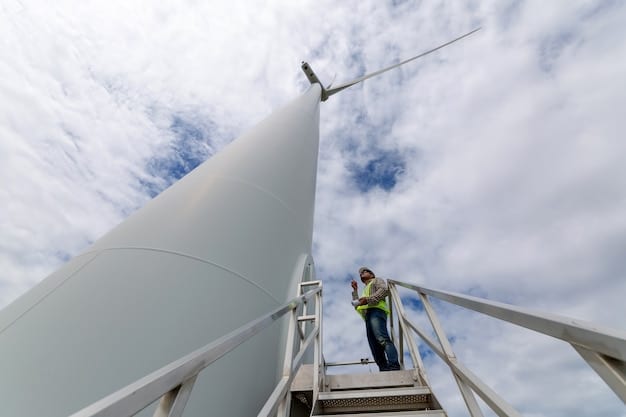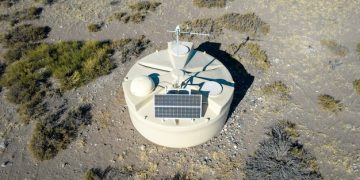US Renewable Energy: How to Benefit from Global Demand

The US is well-positioned to capitalize on the increasing global demand for renewable energy technologies through innovation, policy support, infrastructure development, and international collaboration, leading to economic growth and a sustainable future.
The global shift towards renewable energy presents a significant opportunity for the United States. How is the US positioned to benefit from the growing global demand for renewable energy technologies? The answer lies in its unique combination of technological innovation, policy frameworks, and industrial capabilities.
The US Renewable Energy Landscape
The United States has made substantial strides in the renewable energy sector over the past decade. This progress has largely been driven by technological advancements in solar and wind power, coupled with increasing environmental awareness and supportive government policies.
Current Renewable Energy Capacity
As of late 2024, the US boasts a significant installed capacity of renewable energy sources. This includes wind, solar, hydropower, geothermal, and biomass, with wind and solar leading the charge in terms of growth and contribution to the national energy mix.
Government Policies and Incentives
Federal and state governments have implemented various policies to encourage the adoption of renewable energy. These include tax credits, grants, loan programs, and renewable energy standards, which mandate a certain percentage of electricity to be generated from renewable sources. These policies have been instrumental in driving investment and innovation in the sector.
- Tax credits for solar and wind energy projects.
- Grants and loan programs for renewable energy development.
- Renewable Portfolio Standards (RPS) in many states.
- Federal subsidies for research and development.
The US renewable energy landscape is dynamic and evolving. Continued investment in research, supportive policies, and infrastructure development will be crucial for the US to fully capitalize on the global demand for renewable energy technologies.

Technological Innovation in Renewable Energy
Innovation is at the heart of the US renewable energy sector. American companies and research institutions are consistently pushing the boundaries of what’s possible, developing more efficient and cost-effective renewable energy technologies.
Advancements in Solar Technology
Solar energy has seen remarkable advancements in recent years, with improvements in photovoltaic (PV) cell efficiency, energy storage solutions, and grid integration technologies. These innovations have made solar power more accessible and affordable for both residential and commercial applications.
Wind Energy Innovations
Wind energy has also benefited from technological breakthroughs, including larger and more efficient wind turbines, floating offshore wind farms, and advanced grid management systems. These advancements have increased the capacity and reliability of wind power, making it a key component of the US renewable energy mix.
- Development of more efficient photovoltaic (PV) cells.
- Advancements in battery storage technology.
- Floating offshore wind farms for deeper waters.
- Smart grid technologies for better energy management.
Technological innovation is a key driver of growth in the US renewable energy sector. By continuing to invest in research and development, the US can maintain its competitive edge and capitalize on the global demand for advanced renewable energy technologies.
Manufacturing and Export Opportunities
The growing global demand for renewable energy technologies presents significant manufacturing and export opportunities for the United States. With its strong industrial base and skilled workforce, the US is well-positioned to become a major exporter of renewable energy equipment and services.
Domestic Manufacturing Capacity
The US has a robust manufacturing sector that can support the production of solar panels, wind turbines, batteries, and other renewable energy components. Investing in domestic manufacturing capacity will not only create jobs but also reduce reliance on foreign suppliers.
Export Potential
The US can leverage its technological leadership to export advanced renewable energy technologies to countries around the world. This includes solar PV modules, wind turbines, energy storage systems, and smart grid solutions. Exporting these technologies will boost the US economy and promote sustainable development globally.

- Increasing domestic production of solar panels and wind turbines.
- Exporting advanced energy storage technologies.
- Providing smart grid solutions to developing countries.
- Offering engineering and consulting services for renewable energy projects.
Manufacturing and export opportunities represent a significant avenue for the US to benefit from the global demand for renewable energy technologies. By investing in domestic manufacturing and promoting exports, the US can create jobs, stimulate economic growth, and contribute to a more sustainable world.
Policy and Regulatory Frameworks
Government policies and regulatory frameworks play a critical role in shaping the renewable energy sector. Supportive policies can incentivize investment, promote innovation, and create a level playing field for renewable energy technologies.
Federal Support Mechanisms
The US federal government has implemented various support mechanisms to encourage the development and deployment of renewable energy. These include tax credits, grants, loan guarantees, and research funding. These programs have been instrumental in driving down the cost of renewable energy and making it more competitive with fossil fuels.
State-Level Initiatives
Many US states have also enacted their own renewable energy policies, such as Renewable Portfolio Standards (RPS), which require utilities to obtain a certain percentage of their electricity from renewable sources. These state-level initiatives have been a major driver of renewable energy growth in the US.
- Extending and expanding federal tax credits for renewable energy.
- Implementing carbon pricing mechanisms to internalize the environmental costs of fossil fuels.
- Streamlining permitting processes for renewable energy projects.
- Investing in grid modernization to accommodate more renewable energy.
Effective policy and regulatory frameworks are essential for the continued growth of the US renewable energy sector. By implementing supportive policies at both the federal and state levels, the US can create a favorable environment for investment, innovation, and job creation in the renewable energy industry.
Infrastructure Development and Grid Modernization
Developing robust infrastructure and modernizing the electricity grid are essential for integrating renewable energy sources into the power system. This includes building new transmission lines, upgrading substations, and deploying smart grid technologies.
Transmission Infrastructure
Expanding transmission infrastructure is crucial for transporting electricity from renewable energy-rich areas to population centers. This requires building new high-voltage transmission lines to connect wind farms, solar plants, and other renewable energy facilities to the grid.
Smart Grid Technologies
Smart grid technologies can improve the reliability and efficiency of the electricity grid, enabling better integration of renewable energy sources. This includes advanced metering infrastructure, distribution automation systems, and grid-scale energy storage.
- Investing in new high-voltage transmission lines.
- Upgrading substations to handle increased renewable energy flows.
- Deploying advanced metering infrastructure (AMI).
- Implementing distribution automation systems.
Infrastructure development and grid modernization are critical for unlocking the full potential of renewable energy. By investing in these areas, the US can create a more reliable, efficient, and sustainable energy system.
International Collaboration and Partnerships
International collaboration and partnerships are essential for accelerating the global transition to renewable energy. The US can play a leading role in this effort by sharing its expertise, technology, and best practices with other countries.
Collaborative Research and Development
The US can collaborate with other countries on research and development projects to develop innovative renewable energy technologies. This includes joint research programs, technology transfer agreements, and knowledge-sharing initiatives.
International Trade and Investment
The US can promote international trade and investment in renewable energy technologies by reducing trade barriers, providing financial assistance, and supporting renewable energy projects in developing countries.
- Participating in international renewable energy forums and initiatives.
- Sharing best practices and technical expertise with other countries.
- Promoting international standards for renewable energy technologies.
- Supporting renewable energy projects in developing countries through foreign aid.
International collaboration and partnerships are vital for addressing the global challenge of climate change. By working with other countries, the US can accelerate the transition to a clean energy future and create a more sustainable world.
| Key Highlights | Brief Overview |
|---|---|
| 🌱 Renewable Growth | US renewable energy sector is rapidly growing with advancements in solar and wind technologies. |
| 💡 Innovation | Technological improvements enhance the efficiency and affordability of solar and wind power. |
| 🏭 Manufacturing | Manufacturing and exporting renewable energy technologies boost the US economy. |
| 🤝 Policy Support | Government policies and infrastructure investments drive renewable energy sector growth. |
Frequently Asked Questions
▼
The primary renewable energy sources in the US are solar, wind, hydropower, geothermal, and biomass. Solar and wind energy have seen the most significant growth in recent years, driven by technological advancements and supportive government policies.
▼
Government policies support renewable energy through tax credits, grants, loan programs, and Renewable Portfolio Standards (RPS) at the state level. These policies incentivize investment, promote innovation, and create a level playing field for renewable energy technologies.
▼
Key manufacturing opportunities include the production of solar panels, wind turbines, batteries, and other renewable energy components. Investing in domestic manufacturing capacity can create jobs and reduce reliance on foreign suppliers, boosting the US economy.
▼
Infrastructure development, including building new transmission lines and upgrading substations, is essential for integrating renewable energy sources into the power system. Smart grid technologies can also improve the reliability and efficiency of renewable energy integration.
▼
International collaboration is crucial for accelerating the global transition to renewable energy. The US can share its expertise, technology, and best practices with other countries, as well as collaborate on research and development projects to foster innovation.
Conclusion
The US is uniquely positioned to benefit from the growing global demand for renewable energy technologies. With its innovative spirit, strong industrial base, and supportive policy frameworks, the US can lead the way in developing and deploying clean energy solutions, creating jobs, stimulating economic growth, and contributing to a more sustainable future.





